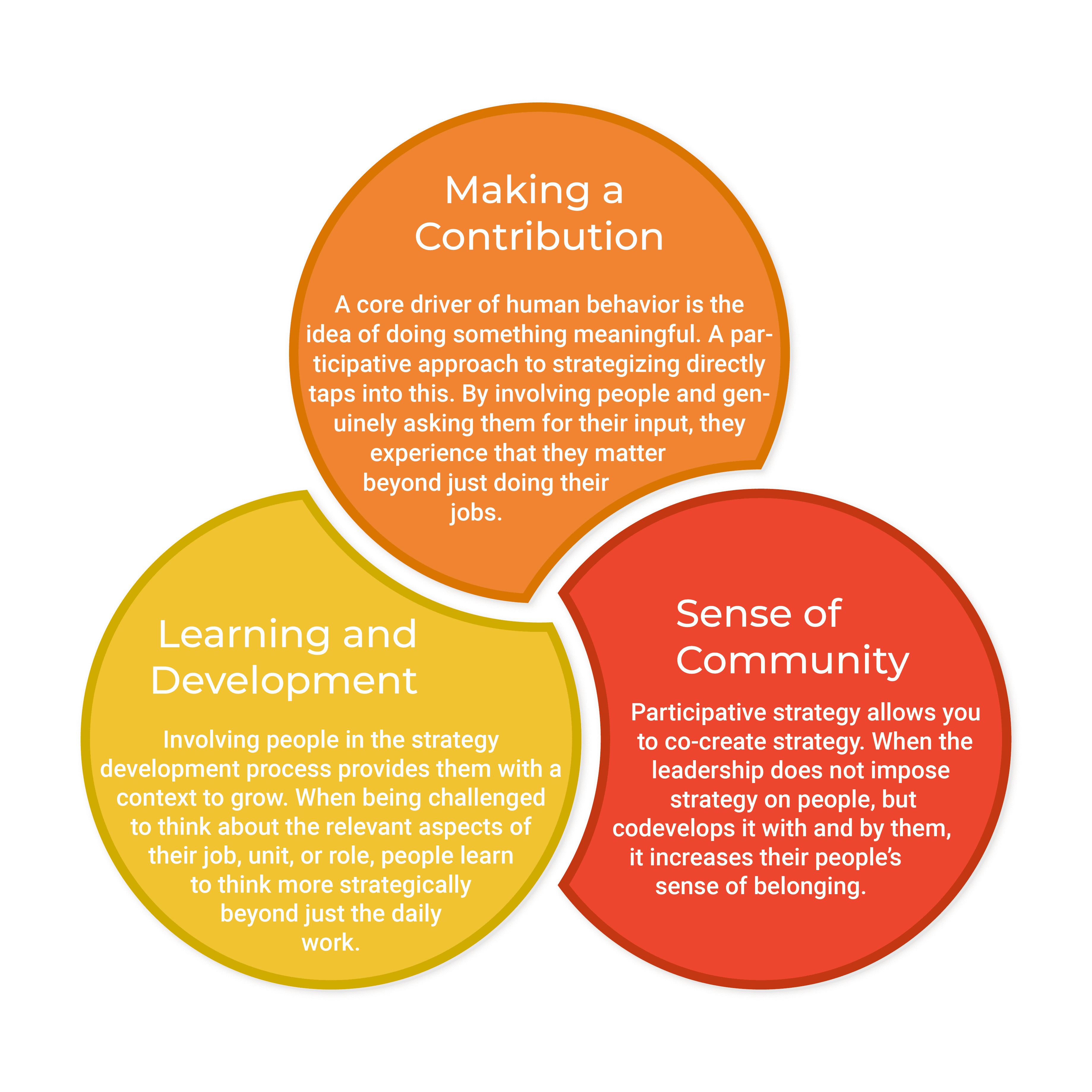Participative strategy development: A collaborative model for talent engagement
- 6 Min Read
An engaging, participative strategy development process does not only lead to better strategy and smoother execution. Jeroen Kraaijenbrink explains how it can also be a key attractor for new hires and create high levels of engagement amongst current staff
- Author: Jeroen Kraaijenbrink
- Date published: Aug 1, 2023
- Categories

As “The Great Attrition” suggests, in many industries attracting and retaining talent is now arguably more difficult than attracting and retaining customers. Organizations need all hands on deck to remain attractive as employers. And yet, HR leaders often overlook participative strategy development as a means to attract and engage talent.
Strategy development used to be a top-down exercise where strategy was developed at the top and supposed to “trickle down” to the rest of the organization. This was often a problem, rather than a solution from an HR perspective. It lacked clarity and engagement and instead caused confusion and frustration.
Decades-long research has consistently shown that a participative approach to strategy development is far more effective. A participative approach to strategy leads to both better strategy and smoother execution. It can also turn the strategizing process into a key HR mechanism for attracting, motivating, and retaining talented staff.
What is participative strategy development?
Participative strategizing does not necessarily mean democracy or bottom-up decision-making. While those may be specific forms, decision-making can still follow the traditional hierarchy of an organization.
First and foremost, participative strategizing requires you to involve more and different people earlier on in the strategy development process. Rather than merely the board or management team, include people from throughout the organization. Crucially, do so not just in the execution phase, but right from the very start of the strategy development process. There are roughly three different ways to achieve this:
- A whole system approach that gets the entire organization in the room.
- A representation approach with a small and diverse core team representing the organization and “peripheral” groups that can give their input in various phases.
- A structural approach with feedback and feedforward routines that collects everyone’s ideas, insights, and issues systematically throughout the year.
Whatever form you use, the point is to collect people’s ideas, insights, and issues and integrate them into strategy development.
Let them do this from their perspective and for the part or aspect of the organization they know something about. This means you’re asking an IT manager about the IT-related aspects of strategy, a business unit manager about what’s relevant from their unit’s perspective, and a CXO about aspects affecting the entire organization. Integrating all these different perspectives is what makes the resulting strategy so strong.
How does participative strategy development add to HR’s impact?
Following the advice above leads to better strategy and smoother execution. It is sufficient to replace a top-down approach with a participative approach to strategizing. From an HR perspective, there are additional reasons why you want such a participative approach. Three significant benefits stand out.
1) Making a contribution
A core driver of human behavior is the idea of doing something meaningful. Of making a contribution. A participative approach to strategizing directly taps into this. By involving people and genuinely asking them for their input, they experience that they matter beyond just doing their jobs. It shows you appreciate people above and beyond their specific skills, for who they are and what they think.
2) Learning and Development
Involving people in the strategy development process provides them with a context to grow. When being challenged to think about the strategically relevant aspects of their job, unit, or role, people learn to think more strategically beyond just the operational day-to-day work they do. Furthermore, in addition to this learning-by-doing aspect, a participative approach to strategy also works great with additional directed strategy training—at all levels.
3) Sense of Community
Participative strategy allows you to co-create strategy. When HR does not impose strategy on people, but codevelops it with and by them, it increases their people’s sense of belonging. After all, they have created the strategy together with their colleagues and managers. The strategy will also be less sensitive to silo-thinking, further enhancing the sense of community.
The downsides of participative strategy development?
If participative strategy-making leads to better strategy and smoother execution, and if it has the three important HR benefits described above, one might ask why not every organization already engages in participative strategy-making.
Objections include that participation will slow down the process, that it triggers a lot of politics and resistance, and that it will lead to a colorless strategy compromise without any bold decisions.
But guess what? The research is again clear on this. Counter to what one might suspect, if there’s anything that research shows, it’s that participative strategizing can speed up the process, reduce politics and resistance, and leads to a strategy that is just as bold or outspoken as any other approach. In short, the downsides are imaginary, and the benefits are real.
What may block more organizations from embracing a participative approach to strategizing is a combination of fear and effort. Fear arises because of the assumed downsides and the fear to lose control and position. Effort blocks progress because transitioning to a participative approach is not easy. Doing it well disrupts how people normally do things in an organization and asks for patience and persistence.
How to get started
Embracing a truly participative approach to strategy development takes time and effort. Simply asking people for input in an email or survey or doing a round of interviews or focus group sessions doesn’t do the job. Truly embracing it asks for a change in mindset, structure, and culture. After all, you open what you have traditionally treated as an exclusive boardroom process.
Moreover, as HR, often you are not in the position to simply change the strategy process. But there are always steps you can make to get started. Here are two:
- Embrace participative strategizing within your sphere of influence by developing your HR strategy in a participative way. Once you show it works there, you may be able to sell it to the board.
- Don’t call it strategy, but develop a mechanism to gather people’s strategic ideas, issues, and insights under the umbrella of leadership development (or whatever term has traction within your organization).
By doing so, your organization can begin to reap the benefits of using this largely untapped HR mechanism.
_______________
Jeroen Kraaijenbrink is an accomplished strategy educator, mentor, author, and consultant with over two decades of experience, extending from academia through business and industry. He empowers people and organizations to discover, formulate, and execute their plans by providing innovative tools for forward-thinking strategy-making and both personal and organizational development.
Drawing from cognitive psychology, humanism, martial arts, Saint Benedict, and a wide range of other sources, he has written innumerable articles on strategy, sustainability, and leadership, as well as authored five books: Strategy Consulting, No More Bananas, Unlearning Strategy, The Strategy Handbook, and The One-Hour Strategy. He is also a contributor to Forbes, where he writes about strategy and leadership.









